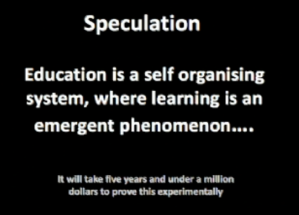Sugata Mitra: A Model of User-Generated Education (Big Ideas Fest)
Education scientist Sugata Mitra tackles one of the greatest problems of education — the best teachers and schools don’t exist where they’re needed most. In a series of real-life experiments from New Delhi to South Africa to Italy, he gave kids self-supervised access to the web and saw results that could revolutionize how we think about teaching (http://www.huffingtonpost.com/tedtalks/sugata-mitra-the-child-dr_b_708043.html).
“If the world belongs to our children then why don’t we just give it to them” was the title of Sugata Mitra’s talk at the Big Ideas Fest during the opening of the conference.
According to Dr. Mitra, Of the 1 billion children on Earth.
- 50 million have ample resources
- 200 million have adequate resources
- 750 million have inadequate resources.
To this Dr. Mitra added, “There are places in every country where, good schools cannot be built and good teachers cannot or do not want to go.” His solution was to install computers with internet access to those places where schools cannot be built and/or teachers do not want to go. It started with a Hole in the Wall in New Dehli. “Where in the slum do you put a computer? Make a DIY ATM! Computer in a wall.”
What he discovered was that, “Groups of children can learn to use computer and the internet irrespective of who or where they are.” Dr. Mitra noted that these kids had no teacher to provide the pedagogy. Can the learners-kids to invent their own pedagogy? Yes, they had done it. “Groups of children can navigate the internet to achieve educational objectives on their own. The bars that children set for themselves can be higher than those we have set for them.”
Dr. Mitra continued to explore what would happen to student learning given the following formula:
- Computers
- Internet Access
- Information and Search Skills
- Reading Comprehension
- Children Working in Groups
- The Right Question
Along with this formula came his teaching style, “I have no idea. And now I am going to go.” He stressed that,
You can drive children with questions. You don’t have to give them the answers. They can find the answers. If the kids/students didn’t get the “right” answer, then teacher didn’t ask the right question. The teacher needs to change question.
The research questions he proposed in his next study, the Kalikuppam Experiment, included:
- Could Tamil- speaking children in a remote Indian village learn basic molecular biology in English on their own?
- Could a friendly mediator with no knowledge of the subject improve the performance of these village children?
- How would the learning and test scores of these children in a remote village compare with those of children who were fluent in English and taught by subject teachers in a local state government school and those attending an affluent, private urban school?
The results to this rearch, Limits to self-organising systems of learning—the
Kalikuppam experiment , were published by the British Journal of Educational Technology.
What are the limits that children can learn in self-organizing systems? Dr. Mitra would like to find out . . .
More about Sugata Mitra and his work can be found at http://sugatam.wikispaces.com/.
Written by Jackie Gerstein, Ed.D.
December 6, 2010 at 3:11 pm
Posted in Education
Tagged with Education, educational reform, global, ideas fest 2010, school reform, social learning, TED talks
This site uses Akismet to reduce spam. Learn how your comment data is processed.


Leave a comment